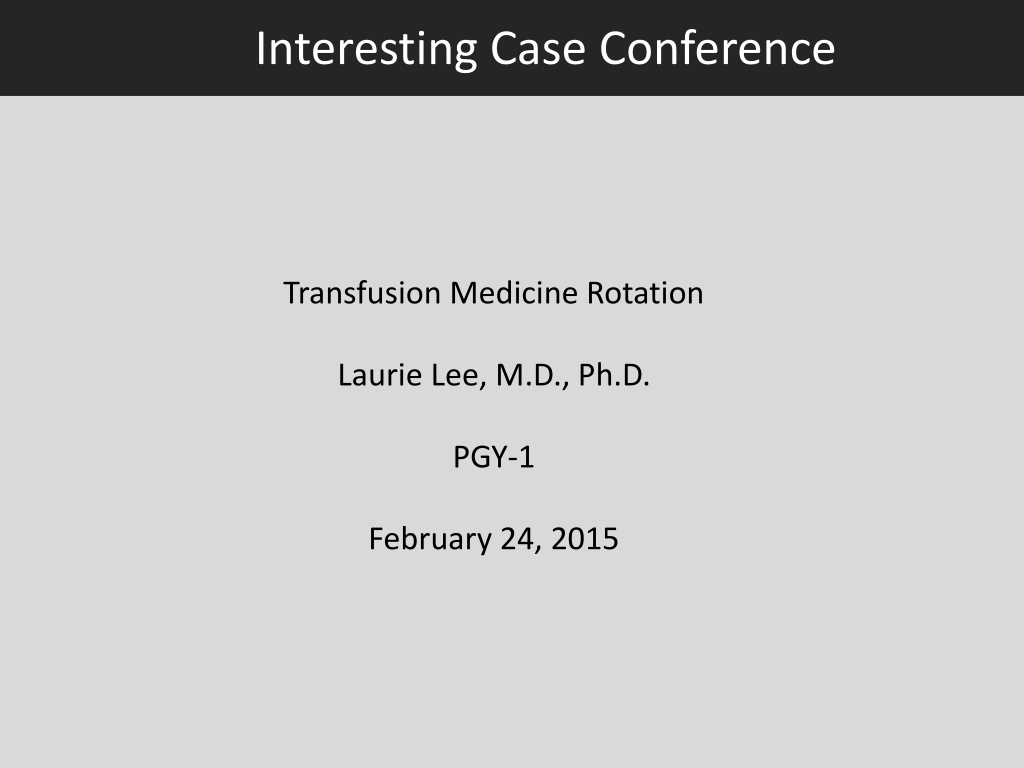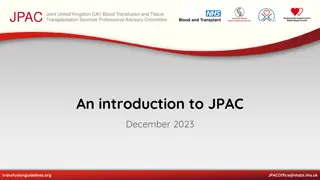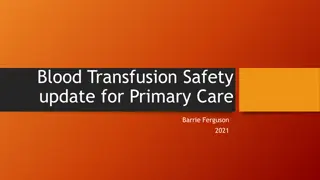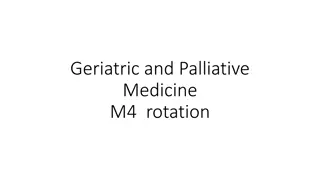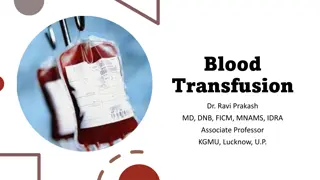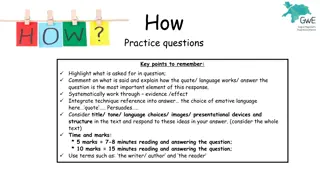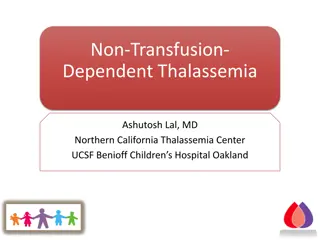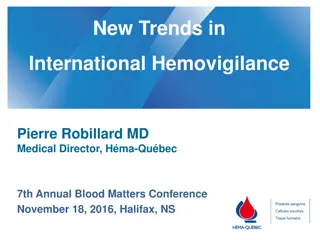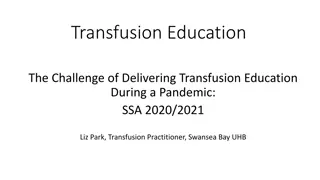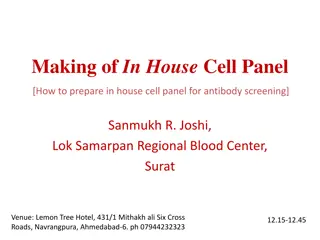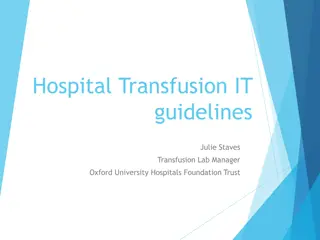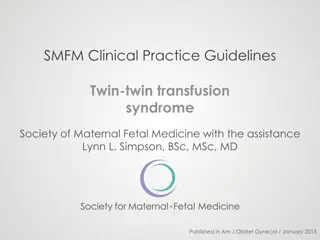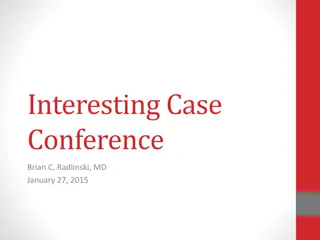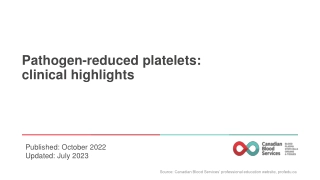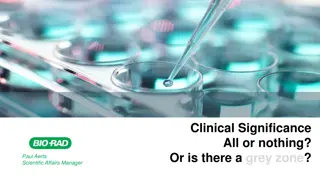Interesting Case Conference - Transfusion Medicine Rotation Laurie Lee, M.D., Ph.D.
One-day-old male infant admitted to the NICU for prematurity and respiratory distress, with a complex maternal history including multiple antibodies. Blood bank tests revealed a positive DAT, and molecular testing identified the patient as positive for JK*A and JK*B alleles. Interpretation suggests potential HDFN risk due to maternal anti-Kidd antibodies.
Download Presentation

Please find below an Image/Link to download the presentation.
The content on the website is provided AS IS for your information and personal use only. It may not be sold, licensed, or shared on other websites without obtaining consent from the author. Download presentation by click this link. If you encounter any issues during the download, it is possible that the publisher has removed the file from their server.
E N D
Presentation Transcript
Interesting Case Conference Transfusion Medicine Rotation Laurie Lee, M.D., Ph.D. PGY-1 February 24, 2015
Case #1: History M.C. (MR# 38465043) Patient history 1 day old male delivered at 33 4/7 weeks by C/S Admitted to NICU on 2/3/15 (DOL1) for management of prematurity and respiratory distress Delivery complicated by pre-eclampsia and poor fetal heart rate variability Apgar scores 6 at 1 min, 8 at 5 min; birth weight 2075 grams Required CPAP and brief PPV at delivery Maternal history 28 yo Polynesian F, now G2 P2 (T0 P2 A0 L2), h/o HTN, CVA, DM II, SLE, and HSV Blood type O positive, Jk(a-b-) [by phenotyping] History of multiple antibodies: anti-Jka, -Jkb, -little c, -big E, -big K, -Fyb, and S Most recent Ab screen at ARC (10/2014) identified only anti-Jka and anti-Jkb
Case #1: Labs Blood bank tests Blood type O positive DAT positive for IgG fixation (2+) Eluate contained panagglutinin that reacted with all cells except the mother s red blood cells Limited antigen phenotype panel o Positive for little c antigen o Negative for Jka and Jkb antigens
Case #1: Molecular testing Patient s blood sample sent to Blood Center of Wisconsin Method Allele-specific PCR of the JK*A [838G] and JK*B[838A] alleles (Kidd) Assay Sensitivity/Specificity >99% in most populations Null alleles [Jk(a-b-)] are not specifically detected and may genotype as JK*A or JK*B alleles Results JK*A [838G] Positive JK*B [838A] Positive
Case #1: Molecular testing Interpretation Mother (sample not genotyped) Most common sequence variation in JK gene in Pacific Islanders causing a null allele is splicing mutation on genetic background of JK+B allele Predicted genotype would be JK*B/JK*B where neither allele is expressed null phenotype [Paternal phenotype reported to be Jk(a+b+)] Patient Phenotyping results invalid due to positive DAT Genotyping results indicate that patient is positive for JK*A and JK*B JK*B in this patient is presumed to be the maternal allele Predicted phenotype is Jk(a+b-) Positive DAT predicts that the mother s anti-Kidd antibodies would cause HDFN due to expression of the Jka antigen in her fetus/newborn
Case #1: Hospital course Respiratory Remains in NICU (admitted 2/3/15 on DOL1) Weaned from CPAP to room air by 2 hr of life; doing well with occasional periods of shallow breathing HDFN concern IVIG given on DOL1 Phototherapy 2/3/15-2/8/15 Monitoring labs, no transfusions to date o Hct: 41% (2/3) o Retic: 15.2% (2/4) 7.4% (2/8) o Tbili: 5.2 mg/dL (2/3) Peak 7.4 (2/8) 5.1 (2/12) 32% (2/18) 29% (2/23) [ref: 38-61%] [ref: 0.5-1.8%] JkA and JkB antigens negative (Clinical team unaware of molecular results?)
The Kidd blood group Kidd protein functions as a urea transporter (389 aa, 10 TM domains) Kidd antigens on RBC surface and on endothelial cells of vasa recta in medulla of human kidney Kidd antigens detected on fetal RBCs as early as 7 weeks of gestation and well developed at birth Two major antigens, Jka and Jkb Prevalence in Caucasians: 50% Jk(a+b+), 26% Jk(a+b-), 23% Jk(a-b+) Jk(a-b-) or null phenotype is rare with increased prevalence in Polynesians (9%) and Finns (1.7%)
Kidd genetics Jka and Jkb are codominant alleles Jka/Jkbpolymorphism: 838G A transition, resulting in D280N substitution Jk gene organized in 11 exons distributed across >30 kb of DNA Polynesian and Finnish Jk null alleles differ o Polynesians: Splice-site mutation (G A) causes skipping of exon 6 o Finnish: T871C substitution predicted to disrupt potential N- glycosylation motif (NSS NSP)
Anti-Kidd group antibodies Uncommon; usually found in sera with other alloantibodies or autoantibodies Mainly IgG (usually capable of crossing placenta); can be partially IgM Can bind complement and cause intravascular and/or extravascular hemolysis Exhibit evanescence and dosage sensitivity Responsible for ~1/3 of all delayed hemolytic transfusion reactions, which may be severe
Anti-Kidd antibodies and HDFN Anti-Kidd antibodies rarely cause hemolytic disease of the fetus and newborn (HDFN) HDFN due to Jkb alloimmunization in pregnancy first reported in 1953 Case report from 2010: To date, only 12 patients have been reported (PubMed) with clinical severity ranging from mild to even fatal outcomes leading to intrauterine and neonatal deaths.
Case #1: Significance Highlights importance of antibody screening in all pregnant women (irrespective of the Rh(D) antigen status) to detect alloimmunization to other clinically significant blood group antigens Highlights potential role of molecular blood group testing in resolving complicated cases (e.g. positive DAT)
Case #1: References Ferrando M, Martinez-Canabate S, Luna I, de la Rubia J, Carpio N, Alfredo P, et al (2008) Severe hemolytic disease of the fetus due to anti-Jkb. Transfusion48:402-404. Irshaid, NM, Henry, SM, Olsson, ML (2000) Genomic characterization of the Kidd blood group gene: different molecular basis of the Jk(a b ) phenotype in Polynesians and Finns. Transfusion 40:69-74. Kim WD, Lee YH (2006) A fatal case of severe hemolytic disease of the newborn associated with anti-Jk(b). J Korean Med Sci 21:151-154. Plaut G, Ikin EW, Mourant AE, Sanger R, Race RR (1953) A new blood-group antibody. Nature171:431. Shaz, BH, Hillyer, CD, Roshal, M, Abrams, CS (2013) Transfusion Medicine and Hemostasis: Second Edition. Elsevier Science. Thakral B, Malhotra S, Saluja K, Kumar P, Marwaha N (2010) Hemolytic disease of newborn due to anti-Jkb in a woman with high risk pregnancy. Transfus Apher Sci 43:41-43. www.ncbi.nlm.nih.gov/books/NBK2272
Case #2: History K.H. (MR# 13269741) Patient history 21 yo female, G3 P2 (T1 P1 A0 L2), with h/o anemia and anti-D, anti-E, and anti-C antibodies who is currently pregnant (EGA 5 weeks). No transfusion hx. No hx of Rhogam administration.
Case #2: Labs Blood bank testing during pregnancy Pregnancy #1 (5/27/10) Patient s blood type: B negative Anti-C and anti-E antibodies identified Pregnancy #2 10/11/13 Anti-C and anti-E antibodies at titers of 1:1 Newly identified anti-D antibody at titer of 1:16 2/27/14 (peri-partum) Anti-D titer rose to 1:256 Baby Rh(D) negative by prenatal genotyping + postnatal geno/phenotyping Current pregnancy #3 (2/22/15) Anti-C antibody at titer of 1:4 Anti-D antibody at titer of 1:128
Case #2: Interpretation **Anti-D -/+ anti-C -/+ anti-G antibodies??** Current testing demonstrates both anti-D and anti-C alloantibodies Previous testing on mother and baby (2nd pregnancy) would suggest these represent anti-G and anti-C alloantibodies Clinical significance True anti-D would portend more significant HDFN If true anti-D is not present, patient would require Rhogam to prevent anti-D alloimmunization if current fetus is Rh(D) positive Recommendation Perform adsorption testing to confirm/rule out presence of anti-D Until results obtained (and/or fetal antigen status determined), would be prudent to assume that patient is not alloimmunized and treat with Rhogam
Case #2: Background G antigen o Present on almost all RBCs that are Rh(C) positive or Rh(D) positive o Absent from cells that are Rh(C) negative and Rh(D) negative Anti-G o Appears serologically to be anti-C plus anti-D o Sort by performing sequential adsorption/elution, e.g. using r (Cde) and R0 (cDe) cells Relevance for transfusion o Differentiation of anti-C, -D, and -G is seldom clinically important o Transfuse with D negative and C negative blood Relevance during pregnancy o Anti-D status would affect pregnancy management D-negative women with anti-G + anti-C (but not anti-D) should receive Rhogam o Warrants further studies to determine true specificities
Case #2: Background Retrospective study that analyzed sera from 27 alloimmunized women initially identified as having anti-D + anti-C Performed adsorption/elution studies to identify anti-D, anti-C, and anti-G Results: Combo Frequency C + G 14.8% D + G 25.9% D + C 11.1% D + C + G 48.1% *Anti-G + anti-C, without anti-D, were identified in 4/27 samples (14.8%) This group should receive Rhogam, but might be missed if interpreted to have anti-D Medicolegal/social implications: Pregnant woman and partner should be informed of anti-G + anti-C identification if both D-negative (paternity issue)
Case #2: References Lenkiewicz B, Zupanska, B (2002) Clinical significance of anti-G. Transfus Med 12:221. Palfi M and Gunnarsson, C (2001) The frequency of anti-C + and anti-G in the absence of anti-D in alloimmunized pregnancies. Transfus Med 11:207-210. Shirey, RS, Mirabella, DC, Lumadue, JA, and Ness, PM (1997) Differentiation of anti-D, -C, and G: clinical relevance in alloimmunized pregnancies. Transfusion37:493-496.
